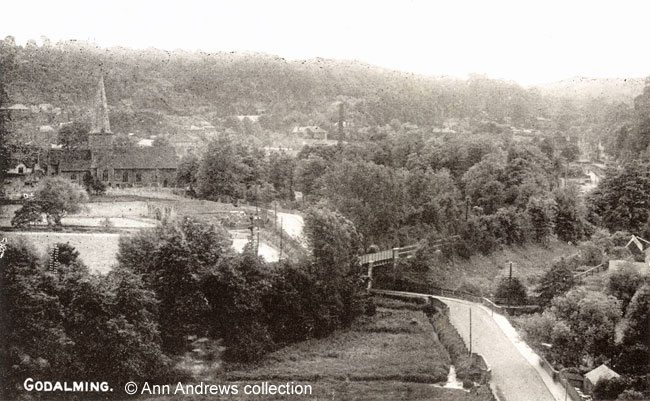This plate girder bridge is on the London to Portsmouth line between Farncombe and Godalming stations, originally
built as part of the London and South Western Railway. The line crosses Borough Road and then crosses the River Wey
almost immediately on its route south towards Godalming Station (formerly known as
Godalming New Station). The road bridge over the river is a few yards behind where the photographer would have stood.
The backdrop to this scene is Frith Hill.
The bridge was built in the mid 1850s when the line was extended southwards. In 1856, at the half yearly meeting of the
Portsmouth Railway company, it was reported that "the works extend almost continuously from the junction with the South-Western
Railway at Godalming to Haslemere", with the expectation that the Godalming to Witley section would be opened the following
autumn[1].
The immaculately cut hedge on the right of the road is a thing of the past. So is the greenery on the left; odd trees and shrubs
remain on the railway embankment, but the land by the roadside is now covered with tarmac. It serves as a car park for Guardian House.

View of the bridge from Frith Hill, with the church on the left, the Phillips Memorial in the centre and Godalming
station on the right. 1912-20. Hell's Ditch is in the foreground.
See: The Phillips Memorial Cloister & RMS Titanic.
When the line was built, those constructing the embankment through this part of Godalming had to navigate past two rivers
(the Ock and the Wey) and several streams as well as a very large pond created in River Wey close to Railway Station.
It served the leather mill on Westbrook Road[2] and and the river flowed under
the mill at that time. The Mill is currently being converted into homes (2024) and there is a bridge over the river instead
of a building.
One of the water courses is known as Hell's Ditch - shown above - and in 1919 it received a very bad press when it was
described as the by medical officer of the day as a "foul watercourse" which was "clothed with weeds and filth,
reported on ... as being contaminated with sewage and manure. At flood times this ditch overflows its banks, flooding thirteen
old cottages, rendering them insanitary and endangering the lives of the inmates. In the summer the children bathe in this filthy
stream[3]." It is highly probable that there was a shortage of able men to carry
out the necessary work at that time. Fortunately, the ditch is not in that state today.
|